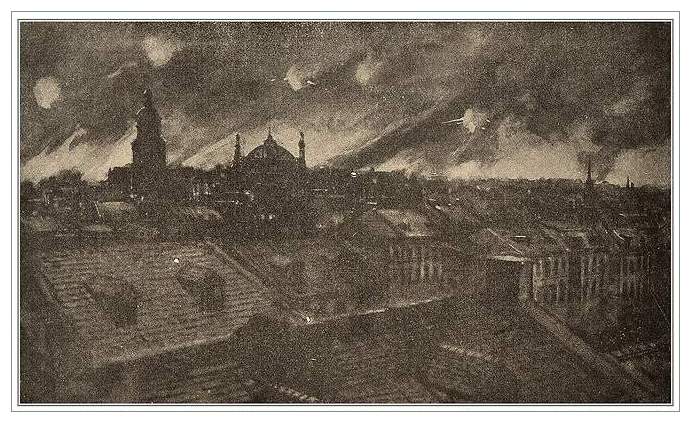
The Fight for the City
”And there came one evening to our ears a sound like the slamming of a distant heavy door. We listened. The sound came again; and again, punctuating the stillness with heavy thuds. And we knew that the siege of Antwerp had begun. The next morning the sound was even more audible in the heavy air. The ominous detonations rumbled like far-off thunder, and the awful echo was tossed back and forth across the grey sky, where a German Taube was flying.
The sound of the guns increased in intensity; it had the quality of a sullen and stupid reiteration, as though there were some argument in the mere bellowing, in the constant asseveration of the same thing. The booming detonations shook the houses; the windows in certain atmospheres would rattle. The weather was grey and heavy; there were frequent gusts of rain, and a general intolerable depression began to settle down upon the world. The people went about with long faces ….. men as they met could only assure each other ….. that the forts of Antwerp were impregnable.”
The impression from Brussels, 30 miles distant. From ‘Belgium Under the German Occupation, A Personal Narrative’ (1919) by Brand Whitlock, US Minister in Belgium during the Great War.

Drawing by H.W. Koekkoek after a sketch war correspondent H.C. Seppings Wright
see other sketches by H.C. Seppings-Wright : Antwerp / Przemysl 1 / Przemysl 2
Magazine illustration of a sketch made by a British correspondant during the bombardment of the city. This was probably made from the roof of the Hotel St. Antoine, the same hotel where American journalist E. Alexander Powell resided during his stay in Antwerp (see the accounts in 'Fighting in Flanders'). British headquarters and several foreign legations were located in this hotel. Belgian Military Headquarters was situated next to the Hotel St. Antoine as well, which made the immediate area a prime and legitimate military target for German artillery. Neither hotel nor Belgian Headquarters were hit by shells and both were afterwards used by the occupying forces as Kommandantur and annex. The block of civilian houses across from the Hotel St. Antoine however was almost totally demolished. After the war, Belgium's first 'skyscraper' was built on this city block.
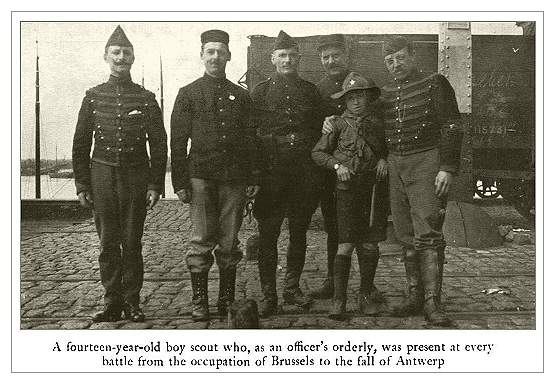
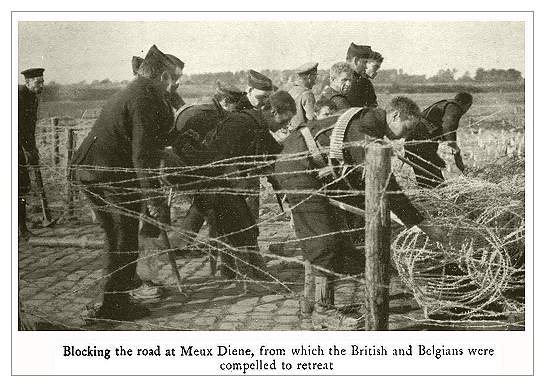
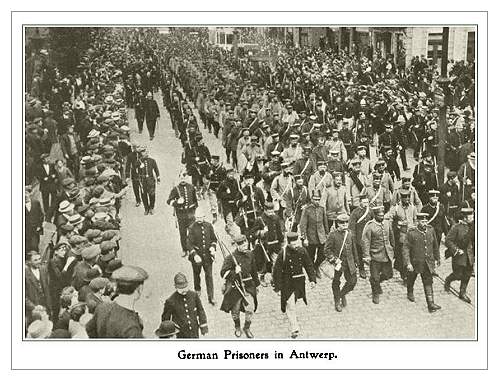
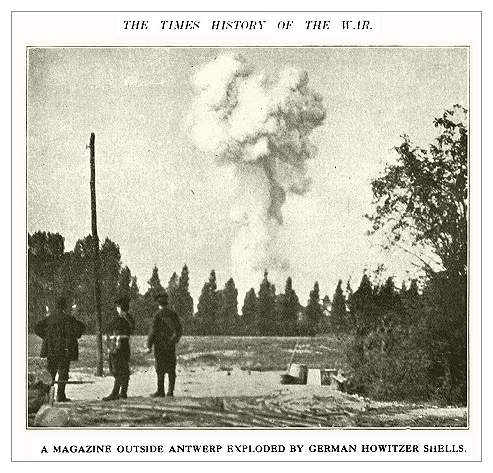
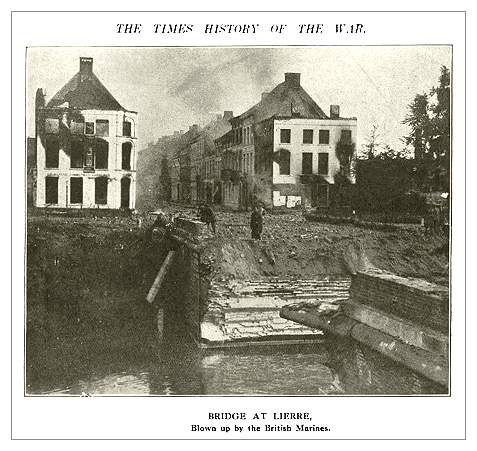
Fighting on the outskirts of the city. Left : a small mushroom cloud rises into the sky as a munitions depot is hit by German shells.
"We would fall asleep at night to the lugubrious booming of those heavy siege-guns that the Austrians had so ostentatiously dragged along the boulevards on their way to Antwerp; and we would awaken to the same sound in wan mornings of care. Now and then there would be the drumming of those iron heels on the pavement and the exultant music of a military band, adding irony to despair.
The incessant thud and rumble shook the house so that it trembled and rattled the windows in their casements; and it got on the nerves. The doom of Antwerp was not far away. One evening Baron von der Lancken said that the Germans had again taken Malines and that they could no more be dislodged. Then another day of heavy detonations, and another and another. One by one the outer forts were falling, and then one morning the Baron came to say that the bombardment of the city itself was about to begin, and would I be so kind as to say to the Belgian Government that if the Belgians would promise not to use the towers of the cathedral and other monuments for military purposes they, the Germans, would promise not to bombard them."
From ‘Belgium Under the German Occupation, A Personal Narrative’ (1919) by Brand Whitlock, US Minister in Belgium during the Great War
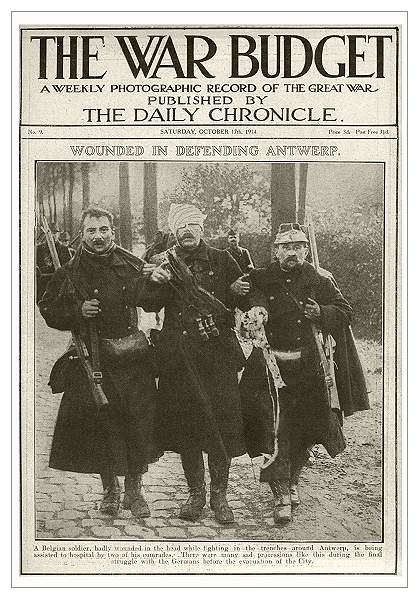
British News Magazine Cover
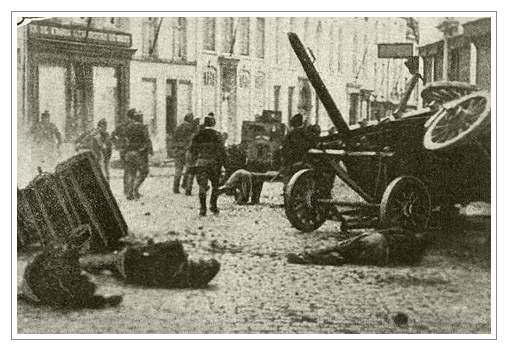
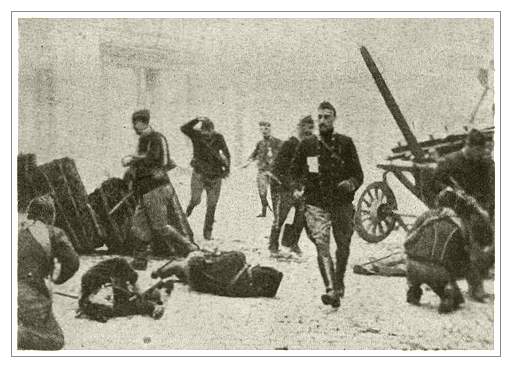
2 dramatic still photographs taken from a cinematograph recording of street fighting in Alost, nearby Antwerp.

Belgian cannon firing from one of the Antwerp forts.
“More and more loudly every minute, as it seemed, the great siege-guns boomed around Antwerp; there were constant movements of troops through the city, a constant drumming of those heavy iron-shod heels on the pavements, the great grey automobiles for ever dashing about, and at last, ambulances rolling in and up to the doors of the Royal Palace and of the Palais des Académies on the boulevard, which the Germans had transformed into a vast military hospital…..
"And all this while the deep detonations of the cannons north of us sounded heavily in the ear and on the heart, rising steadily to its terrible crescendo that was to mark the finale of another movement in the great fugue. On the 5th, Les Nouvelles Publiées par le Gouvernement Allemand announced that the outer forts of Lierre, Waelhem, Koningsoeyt, and the intermediary redoubts had fallen, and that through the breach in the circle of exterior forts the Germans were now able to push the attack against the inner circle of forts and against the city itself. The people had been convinced that Antwerp was impregnable; they had awaited the issue of the siege with confidence, thinking that relief would come. But now among those classes which, if not the more intelligent, had better means of information doubt had grown, and they began to consider the possibility of the fall of Antwerp. And then - what would become of the King and the Queen, the Court and the Government? No one could envisage the situation. It was impossible to take any large view of it, the mind refused longer to receive any impression of this vast epopée that was being enacted on the huge theatre of Europe. We simply could not realize it, that was all …….”
From ‘Belgium Under the German Occupation, A Personal Narrative’ (1919) by Brand Whitlock, US Minister in Belgium during the Great War
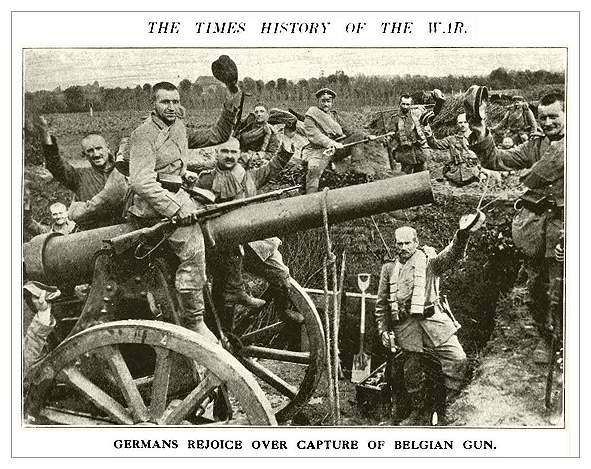

The fight for Antwerp may have been over, but the fight for Belgium had just begun. The army escaped by way of Ghent and Bruges and encamped at Ostend. In the face of a German drive for the channel ports of Calais and Dunkerque, the Belgian Army retreated once more. Behind the river Yser and the elevated earthen railway embankment to Dixmuide, military and civilian engineers opened sluice and lock gates, flooding low lying areas and halting the German advance after furious fighting in villages and amongst the sand dunes on the coast. French and British forces took up positions to the right of the Belgian armies and held the area that would become famous as the Ypres Salient.
Here is a photo of Belgian soldiers, evacuated by rail. Many arrived at Dunkerque (see the account Soul of War), ragged and exhausted but ready to go on fighting. One of the soldiers in the photo sports a captured German Uhlan's helmet, while another soldier wears the fur busbie of the Belgian Regiment of Guides.